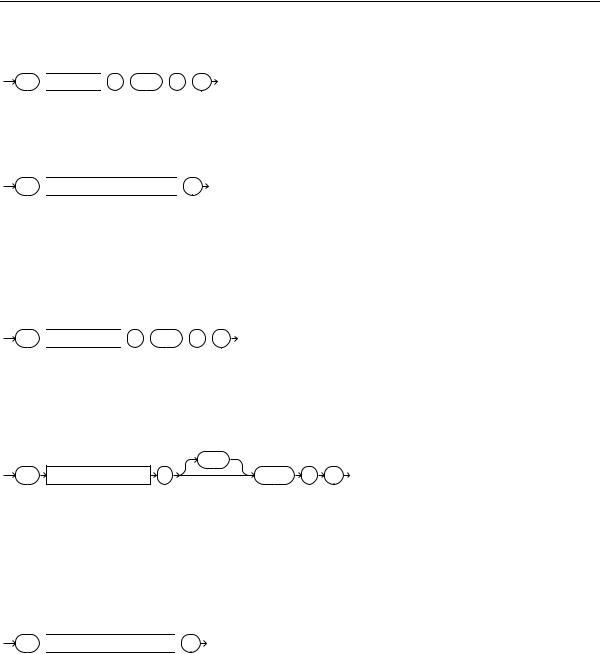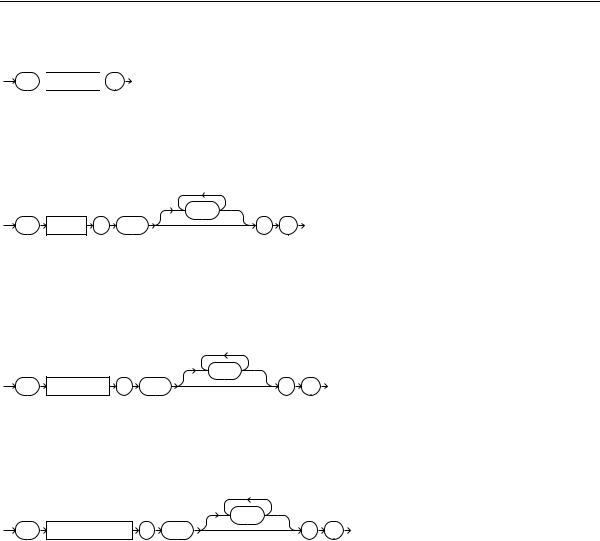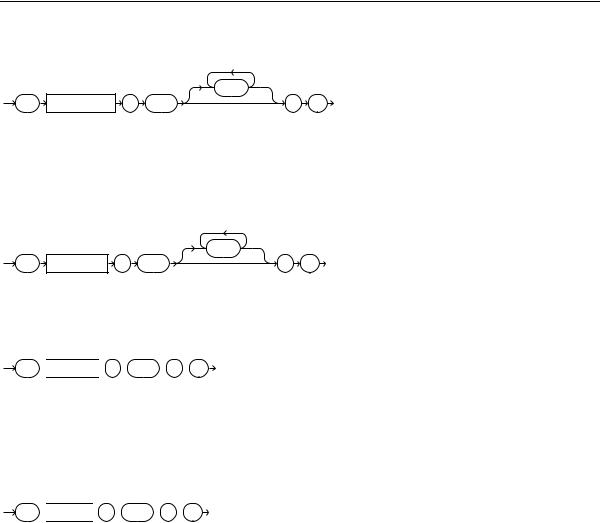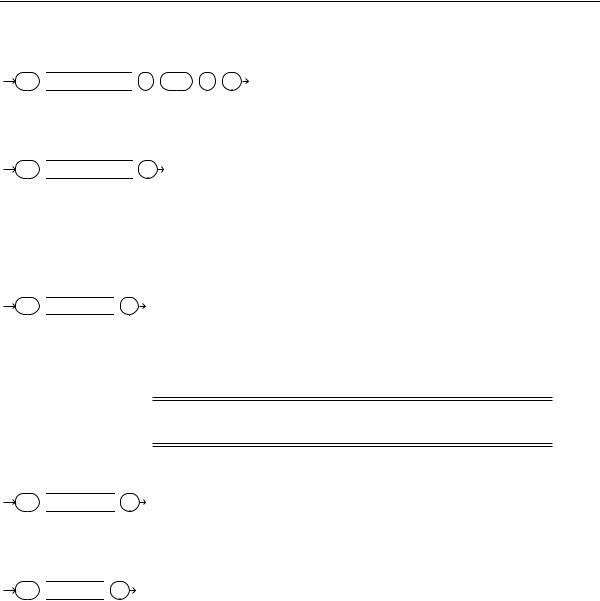
- •Contents
- •Send Us Your Comments
- •Preface
- •What’s New in SQL Reference?
- •1 Introduction to Oracle SQL
- •History of SQL
- •SQL Standards
- •Embedded SQL
- •Lexical Conventions
- •Tools Support
- •2 Basic Elements of Oracle SQL
- •Datatypes
- •Oracle Built-in Datatypes
- •ANSI, DB2, and SQL/DS Datatypes
- •Oracle-Supplied Types
- •"Any" Types
- •XML Types
- •Spatial Type
- •Media Types
- •Datatype Comparison Rules
- •Data Conversion
- •Literals
- •Text Literals
- •Integer Literals
- •Number Literals
- •Interval Literals
- •Format Models
- •Number Format Models
- •Date Format Models
- •String-to-Date Conversion Rules
- •XML Format Model
- •Nulls
- •Nulls in SQL Functions
- •Nulls with Comparison Conditions
- •Nulls in Conditions
- •Pseudocolumns
- •CURRVAL and NEXTVAL
- •LEVEL
- •ROWID
- •ROWNUM
- •XMLDATA
- •Comments
- •Comments Within SQL Statements
- •Comments on Schema Objects
- •Hints
- •Database Objects
- •Schema Objects
- •Nonschema Objects
- •Parts of Schema Objects
- •Schema Object Names and Qualifiers
- •Schema Object Naming Rules
- •Schema Object Naming Examples
- •Schema Object Naming Guidelines
- •Syntax for Schema Objects and Parts in SQL Statements
- •How Oracle Resolves Schema Object References
- •Referring to Objects in Other Schemas
- •Referring to Objects in Remote Databases
- •Referencing Object Type Attributes and Methods
- •3 Operators
- •About SQL Operators
- •Unary and Binary Operators
- •Operator Precedence
- •Arithmetic Operators
- •Concatenation Operator
- •Set Operators
- •4 Expressions
- •About SQL Expressions
- •Simple Expressions
- •Compound Expressions
- •CASE Expressions
- •CURSOR Expressions
- •Datetime Expressions
- •Function Expressions
- •INTERVAL Expressions
- •Object Access Expressions
- •Scalar Subquery Expressions
- •Type Constructor Expressions
- •Variable Expressions
- •Expression Lists
- •5 Conditions
- •About SQL Conditions
- •Condition Precedence
- •Comparison Conditions
- •Simple Comparison Conditions
- •Group Comparison Conditions
- •Logical Conditions
- •Membership Conditions
- •Range Conditions
- •Null Conditions
- •EQUALS_PATH
- •EXISTS Conditions
- •LIKE Conditions
- •IS OF type Conditions
- •UNDER_PATH
- •Compound Conditions
- •6 Functions
- •SQL Functions
- •Single-Row Functions
- •Aggregate Functions
- •Analytic Functions
- •Object Reference Functions
- •Alphabetical Listing of SQL Functions
- •ACOS
- •ADD_MONTHS
- •ASCII
- •ASCIISTR
- •ASIN
- •ATAN
- •ATAN2
- •BFILENAME
- •BITAND
- •CAST
- •CEIL
- •CHARTOROWID
- •COALESCE
- •COMPOSE
- •CONCAT
- •CONVERT
- •CORR
- •COSH
- •COUNT
- •COVAR_POP
- •COVAR_SAMP
- •CUME_DIST
- •CURRENT_DATE
- •CURRENT_TIMESTAMP
- •DBTIMEZONE
- •DECODE
- •DECOMPOSE
- •DENSE_RANK
- •DEPTH
- •DEREF
- •DUMP
- •EMPTY_BLOB, EMPTY_CLOB
- •EXISTSNODE
- •EXTRACT (datetime)
- •EXTRACT (XML)
- •EXTRACTVALUE
- •FIRST
- •FIRST_VALUE
- •FLOOR
- •FROM_TZ
- •GREATEST
- •GROUP_ID
- •GROUPING
- •GROUPING_ID
- •HEXTORAW
- •INITCAP
- •INSTR
- •LAST
- •LAST_DAY
- •LAST_VALUE
- •LEAD
- •LEAST
- •LENGTH
- •LOCALTIMESTAMP
- •LOWER
- •LPAD
- •LTRIM
- •MAKE_REF
- •MONTHS_BETWEEN
- •NCHR
- •NEW_TIME
- •NEXT_DAY
- •NLS_CHARSET_DECL_LEN
- •NLS_CHARSET_ID
- •NLS_CHARSET_NAME
- •NLS_INITCAP
- •NLS_LOWER
- •NLSSORT
- •NLS_UPPER
- •NTILE
- •NULLIF
- •NUMTODSINTERVAL
- •NUMTOYMINTERVAL
- •PATH
- •PERCENT_RANK
- •PERCENTILE_CONT
- •PERCENTILE_DISC
- •POWER
- •RANK
- •RATIO_TO_REPORT
- •RAWTOHEX
- •RAWTONHEX
- •REFTOHEX
- •REGR_ (Linear Regression) Functions
- •REPLACE
- •ROUND (number)
- •ROUND (date)
- •ROW_NUMBER
- •ROWIDTOCHAR
- •ROWIDTONCHAR
- •RPAD
- •RTRIM
- •SESSIONTIMEZONE
- •SIGN
- •SINH
- •SOUNDEX
- •SQRT
- •STDDEV
- •STDDEV_POP
- •STDDEV_SAMP
- •SUBSTR
- •SYS_CONNECT_BY_PATH
- •SYS_CONTEXT
- •SYS_DBURIGEN
- •SYS_EXTRACT_UTC
- •SYS_GUID
- •SYS_TYPEID
- •SYS_XMLAGG
- •SYS_XMLGEN
- •SYSDATE
- •SYSTIMESTAMP
- •TANH
- •TO_CHAR (character)
- •TO_CHAR (datetime)
- •TO_CHAR (number)
- •TO_CLOB
- •TO_DATE
- •TO_DSINTERVAL
- •TO_MULTI_BYTE
- •TO_NCHAR (character)
- •TO_NCHAR (datetime)
- •TO_NCHAR (number)
- •TO_NCLOB
- •TO_NUMBER
- •TO_SINGLE_BYTE
- •TO_TIMESTAMP
- •TO_TIMESTAMP_TZ
- •TO_YMINTERVAL
- •TRANSLATE
- •TRANSLATE ... USING
- •TREAT
- •TRIM
- •TRUNC (number)
- •TRUNC (date)
- •TZ_OFFSET
- •UNISTR
- •UPDATEXML
- •UPPER
- •USER
- •USERENV
- •VALUE
- •VAR_SAMP
- •VARIANCE
- •VSIZE
- •WIDTH_BUCKET
- •XMLAGG
- •XMLCOLATTVAL
- •XMLCONCAT
- •XMLELEMENT
- •XMLFOREST
- •XMLSEQUENCE
- •XMLTRANSFORM
- •ROUND and TRUNC Date Functions
- •User-Defined Functions
- •Prerequisites
- •Name Precedence
- •7 Common SQL DDL Clauses
- •allocate_extent_clause
- •constraints
- •deallocate_unused_clause
- •file_specification
- •logging_clause
- •parallel_clause
- •physical_attributes_clause
- •storage_clause
- •8 SQL Queries and Subqueries
- •About Queries and Subqueries
- •Creating Simple Queries
- •Hierarchical Queries
- •The UNION [ALL], INTERSECT, MINUS Operators
- •Sorting Query Results
- •Joins
- •Using Subqueries
- •Unnesting of Nested Subqueries
- •Selecting from the DUAL Table
- •Distributed Queries
- •9 SQL Statements: ALTER CLUSTER to ALTER SEQUENCE
- •Types of SQL Statements
- •Organization of SQL Statements
- •ALTER CLUSTER
- •ALTER DATABASE
- •ALTER DIMENSION
- •ALTER FUNCTION
- •ALTER INDEX
- •ALTER INDEXTYPE
- •ALTER JAVA
- •ALTER MATERIALIZED VIEW
- •ALTER MATERIALIZED VIEW LOG
- •ALTER OPERATOR
- •ALTER OUTLINE
- •ALTER PACKAGE
- •ALTER PROCEDURE
- •ALTER PROFILE
- •ALTER RESOURCE COST
- •ALTER ROLE
- •ALTER ROLLBACK SEGMENT
- •ALTER SEQUENCE
- •10 SQL Statements: ALTER SESSION to ALTER SYSTEM
- •ALTER SESSION
- •ALTER SYSTEM
- •ALTER TABLE
- •ALTER TABLESPACE
- •ALTER TRIGGER
- •ALTER TYPE
- •ALTER USER
- •ALTER VIEW
- •ANALYZE
- •ASSOCIATE STATISTICS
- •AUDIT
- •CALL
- •COMMENT
- •COMMIT
- •13 SQL Statements: CREATE CLUSTER to CREATE JAVA
- •CREATE CLUSTER
- •CREATE CONTEXT
- •CREATE CONTROLFILE
- •CREATE DATABASE
- •CREATE DATABASE LINK
- •CREATE DIMENSION
- •CREATE DIRECTORY
- •CREATE FUNCTION
- •CREATE INDEX
- •CREATE INDEXTYPE
- •CREATE JAVA
- •14 SQL Statements: CREATE LIBRARY to CREATE SPFILE
- •CREATE LIBRARY
- •CREATE MATERIALIZED VIEW
- •CREATE MATERIALIZED VIEW LOG
- •CREATE OPERATOR
- •CREATE OUTLINE
- •CREATE PACKAGE
- •CREATE PACKAGE BODY
- •CREATE PFILE
- •CREATE PROCEDURE
- •CREATE PROFILE
- •CREATE ROLE
- •CREATE ROLLBACK SEGMENT
- •CREATE SCHEMA
- •CREATE SEQUENCE
- •CREATE SPFILE
- •15 SQL Statements: CREATE SYNONYM to CREATE TRIGGER
- •CREATE SYNONYM
- •CREATE TABLE
- •CREATE TABLESPACE
- •CREATE TEMPORARY TABLESPACE
- •CREATE TRIGGER
- •CREATE TYPE
- •CREATE TYPE BODY
- •CREATE USER
- •CREATE VIEW
- •DELETE
- •DISASSOCIATE STATISTICS
- •DROP CLUSTER
- •DROP CONTEXT
- •DROP DATABASE LINK
- •DROP DIMENSION
- •DROP DIRECTORY
- •DROP FUNCTION
- •DROP INDEX
- •DROP INDEXTYPE
- •DROP JAVA
- •DROP LIBRARY
- •DROP MATERIALIZED VIEW
- •DROP MATERIALIZED VIEW LOG
- •DROP OPERATOR
- •DROP OUTLINE
- •DROP PACKAGE
- •DROP PROCEDURE
- •DROP PROFILE
- •DROP ROLE
- •DROP ROLLBACK SEGMENT
- •17 SQL Statements: DROP SEQUENCE to ROLLBACK
- •DROP SEQUENCE
- •DROP SYNONYM
- •DROP TABLE
- •DROP TABLESPACE
- •DROP TRIGGER
- •DROP TYPE
- •DROP TYPE BODY
- •DROP USER
- •DROP VIEW
- •EXPLAIN PLAN
- •GRANT
- •INSERT
- •LOCK TABLE
- •MERGE
- •NOAUDIT
- •RENAME
- •REVOKE
- •ROLLBACK
- •18 SQL Statements: SAVEPOINT to UPDATE
- •SAVEPOINT
- •SELECT
- •SET CONSTRAINT[S]
- •SET ROLE
- •SET TRANSACTION
- •TRUNCATE
- •UPDATE
- •Required Keywords and Parameters
- •Optional Keywords and Parameters
- •Syntax Loops
- •Multipart Diagrams
- •Database Objects
- •ANSI Standards
- •ISO Standards
- •Oracle Compliance
- •FIPS Compliance
- •Oracle Extensions to Standard SQL
- •Character Set Support
- •Using Extensible Indexing
- •Using XML in SQL Statements
- •Index

Comments
Comments
You can associate comments with SQL statements and schema objects.
Comments Within SQL Statements
Comments within SQL statements do not affect the statement execution, but they may make your application easier for you to read and maintain. You may want to include a comment in a statement that describes the statement’s purpose within your application.
A comment can appear between any keywords, parameters, or punctuation marks in a statement. You can include a comment in a statement using either of these means:
■Begin the comment with a slash and an asterisk (/*). Proceed with the text of the comment. This text can span multiple lines. End the comment with an asterisk and a slash (*/). The opening and terminating characters need not be separated from the text by a space or a line break.
■Begin the comment with -- (two hyphens). Proceed with the text of the comment. This text cannot extend to a new line. End the comment with a line break.
A SQL statement can contain multiple comments of both styles. The text of a comment can contain any printable characters in your database character set.
Example These statements contain many comments:
SELECT last_name, salary + NVL(commission_pct, 0), job_id, e.department_id
/* Select all employees whose compensation is greater than that of Pataballa.*/
FROM employees e, departments d
/*The DEPARTMENTS table is used to get the department name.*/
WHERE e.department_id = d.department_id |
|
|
|
AND salary + NVL(commission_pct,0) > |
/* Subquery: |
*/ |
|
(SELECT salary + NVL(commission_pct,0) |
|
|
|
|
/* total compensation is salar + commission_pct */ |
||
FROM employees |
|
|
|
WHERE last_name = ’Pataballa’); |
|
|
|
SELECT last_name, |
-- select the name |
|
|
salary + NVL(commission_pct, 0),-- total compensation |
|
||
job_id, |
-- job |
|
|
2-90 Oracle9i SQL Reference

Comments
e.department_id |
-- |
and department |
FROM employees e, |
-- |
of all employees |
departments d |
|
WHERE e.department_id = d.department_id |
|
AND salary + NVL(commission_pct, 0) > |
-- whose compensation |
|
-- is greater than |
(SELECT salary + NVL(commission_pct,0) -- the compensation |
|
FROM employees |
|
WHERE last_name = ’Pataballa’) |
-- of Pataballa. |
;
Comments on Schema Objects
You can associate a comment with a table, view, materialized view, or column using the COMMENT command. Comments associated with schema objects are stored in the data dictionary.
See Also: COMMENT on page 12-72 for a description of comments
Hints
You can use comments in a SQL statement to pass instructions, or hints, to the Oracle optimizer. The optimizer uses these hints as suggestions for choosing an execution plan for the statement.
A statement block can have only one comment containing hints, and that comment must follow the SELECT, UPDATE, INSERT, or DELETE keyword. The following syntax shows hints contained in both styles of comments that Oracle supports within a statement block.
{DELETE|INSERT|SELECT|UPDATE} /*+ hint [text] [hint[text]]... */
or
{DELETE|INSERT|SELECT|UPDATE} --+ hint [text] [hint[text]]...
where:
■DELETE, INSERT, SELECT, or UPDATE is a DELETE, INSERT, SELECT, or
UPDATE keyword that begins a statement block. Comments containing hints can appear only after these keywords.
■+ is a plus sign that causes Oracle to interpret the comment as a list of hints. The plus sign must follow immediately after the comment delimiter (no space is permitted).
Basic Elements of Oracle SQL 2-91

Comments
■hint is one of the hints discussed in this section. The space between the plus sign and the hint is optional. If the comment contains multiple hints, then separate the hints by at least one space.
■text is other commenting text that can be interspersed with the hints.
Table 2–22 lists the hints by functional category. An alphabetical listing of the hints, including the syntax and a brief description of each hint, follow the table.
Note: Oracle treats misspelled hints as regular comments and does not return an error.
See Also: Oracle9i Database Performance Tuning Guide and Reference and Oracle9i Database Concepts for more information on hints
Table 2–22 Hints by Functional Category
Category |
Hint |
|
|
Optimization Goals and Approaches |
ALL_ROWS and FIRST_ROWS |
|
CHOOSE |
|
RULE |
|
|
Access Method Hints |
AND_EQUAL |
|
CLUSTER |
|
FULL |
|
HASH |
|
INDEX and NO_INDEX |
|
INDEX_ASC and INDEX_DESC |
|
INDEX_COMBINE |
|
INDEX_FFS |
|
ROWID |
|
|
Join Order Hints |
ORDERED |
|
STAR |
|
|
2-92 Oracle9i SQL Reference

Comments
Table 2–22 (Cont.) Hints by Functional Category
Category |
Hint |
|
|
Join Operation Hints |
DRIVING_SITE |
|
HASH_SJ, MERGE_SJ, and NL_SJ |
|
LEADING |
|
USE_HASH and USE_MERGE |
|
USE_NL |
|
|
Parallel Execution Hints |
PARALLEL and NOPARALLEL |
|
PARALLEL_INDEX |
|
PQ_DISTRIBUTE |
|
NOPARALLEL_INDEX |
|
|
Query Transformation Hints |
EXPAND_GSET_TO_UNION |
|
FACT and NOFACT |
|
MERGE |
|
NO_EXPAND |
|
NO_MERGE |
|
REWRITE and NOREWRITE |
|
STAR_TRANSFORMATION |
|
USE_CONCAT |
|
|
Other Hints |
APPEND and NOAPPEND |
|
CACHE and NOCACHE |
|
CURSOR_SHARING_EXACT |
|
DYNAMIC_SAMPLING |
|
NESTED_TABLE_GET_REFS |
|
UNNEST and NO_UNNEST |
|
ORDERED_PREDICATES |
|
PUSH_PRED and NO_PUSH_PRED |
|
PUSH_SUBQ and NO_PUSH_SUBQ |
|
|
all_rows_hint::=
/*+  ALL_ROWS
ALL_ROWS  */
*/
Basic Elements of Oracle SQL 2-93

Comments
The ALL_ROWS hint explicitly chooses the cost-based approach to optimize a statement block with a goal of best throughput (that is, minimum total resource consumption).
and_equal_hint::=
|
|
|
|
|
index |
index |
index |
|
/*+ |
AND_EQUAL |
( |
table |
index |
index |
|
) |
*/ |
The AND_EQUAL hint explicitly chooses an execution plan that uses an access path that merges the scans on several single-column indexes.
append_hint::=
/*+  APPEND
APPEND  */
*/
The APPEND hint lets you enable direct-path INSERT if your database is running in serial mode. Your database is in serial mode if you are not using Enterprise Edition. Conventional INSERT is the default in serial mode, and direct-path INSERT is the default in parallel mode.
In direct-path INSERT, data is appended to the end of the table, rather than using existing space currently allocated to the table. As a result, direct-path INSERT can be considerably faster than conventional INSERT.
cache_hint::=
/*+  CACHE
CACHE  (
(  table
table  )
)  */
*/
The CACHE hint specifies that the blocks retrieved for the table are placed at the most recently used end of the LRU list in the buffer cache when a full table scan is performed. This option is useful for small lookup tables.
choose_hint::=
/*+  CHOOSE
CHOOSE  */
*/
The CHOOSE hint causes the optimizer to choose between the rule-based and cost-based approaches for a SQL statement. The optimizer bases its selection on the presence of statistics for the tables accessed by the statement. If the data dictionary has statistics for at least one of these tables, then the optimizer uses the cost-based approach and optimizes with the goal of best throughput. If the data dictionary does not have statistics for these tables, then it uses the rule-based approach.
2-94 Oracle9i SQL Reference

Comments
cluster_hint::=
/*+  CLUSTER
CLUSTER  (
(  table
table  )
)  */
*/
The CLUSTER hint explicitly chooses a cluster scan to access the specified table. It applies only to clustered objects.
cursor_sharing_exact_hint::=
/*+  CURSOR_SHARING_EXACT
CURSOR_SHARING_EXACT  */
*/
Oracle can replace literals in SQL statements with bind variables, if it is safe to do so. This is controlled with the CURSOR_SHARING startup parameter. The CURSOR_ SHARING_EXACT hint causes this behavior to be switched off. In other words, Oracle executes the SQL statement without any attempt to replace literals by bind variables.
driving_site_hint::=
/*+  DRIVING_SITE
DRIVING_SITE  (
(  table
table  )
)  */
*/
The DRIVING_SITE hint forces query execution to be done at a different site than that selected by Oracle. This hint can be used with either rule-based or cost-based optimization.
dynamic_sampling_hint::=
|
|
|
table |
|
|
/*+ |
DYNAMIC_SAMPLING |
( |
integer |
) |
*/ |
The DYNAMIC_SAMPLING hint lets you control dynamic sampling to improve server performance by determining more accurate selectivity and cardinality estimates. You can set the value of DYNAMIC_SAMPLING to a value from 0 to 10. The higher the level, the more effort the compiler puts into dynamic sampling and the more broadly it is applied. Sampling defaults to cursor level unless you specify a table.
expand_gset_to_union_hint::=
/*+  EXPAND_GSET_TO_UNION
EXPAND_GSET_TO_UNION  */
*/
The EXPAND_GSET_TO_UNION hint is used for queries containing grouping sets (such as queries with GROUP BY GROUPING SET or GROUP BY ROLLUP). The hint
Basic Elements of Oracle SQL 2-95

Comments
forces a query to be transformed into a corresponding query with UNION ALL of individual groupings.
fact_hint::=
/*+  FACT
FACT  (
(  table
table  )
)  */
*/
The FACT hint is used in the context of the star transformation to indicate to the transformation that the hinted table should be considered as a fact table.
first_rows_hint::=
/*+  FIRST_ROWS
FIRST_ROWS  (
(  n
n  )
)  */
*/
The hints FIRST_ROWS(n) (where n is any positive integer) or FIRST_ROWS instruct Oracle to optimize an individual SQL statement for fast response. FIRST_ ROWS(n) affords greater precision, because it instructs Oracle to choose the plan that returns the first n rows most efficiently. The FIRST_ROWS hint, which optimizes for the best plan to return the first single row, is retained for backward compatibility and plan stability.
full_hint::=
/*+  FULL
FULL  (
(  table
table  )
)  */
*/
The FULL hint explicitly chooses a full table scan for the specified table.
hash_hint::=
/*+  HASH
HASH  (
(  table
table  )
)  */
*/
The HASH hint explicitly chooses a hash scan to access the specified table. It applies only to tables stored in a cluster.
hash_aj_hint::=
/*+  HASH_AJ
HASH_AJ  */
*/
For a specific query, place the HASH_SJ, MERGE_SJ, or NL_SJ hint into the EXISTS subquery. HASH_SJ uses a hash semi-join, MERGE_SJ uses a sort merge semi-join, and NL_SJ uses a nested loop semi-join.
2-96 Oracle9i SQL Reference

Comments
hash_sj_hint::=
/*+  HASH_SJ
HASH_SJ  */
*/
For a specific query, place the HASH_SJ, MERGE_SJ, or NL_SJ hint into the EXISTS subquery. HASH_SJ uses a hash semi-join, MERGE_SJ uses a sort merge semi-join, and NL_SJ uses a nested loop semi-join.
index_hint::=
|
|
|
|
index |
|
/*+ |
INDEX |
( |
table |
) |
*/ |
The INDEX hint explicitly chooses an index scan for the specified table. You can use the INDEX hint for domain, B-tree, bitmap, and bitmap join indexes. However, Oracle recommends using INDEX_COMBINE rather than INDEX for bitmap indexes, because it is a more versatile hint.
index_asc_hint::=
|
|
|
|
index |
|
/*+ |
INDEX_ASC |
( |
table |
) |
*/ |
The INDEX_ASC hint explicitly chooses an index scan for the specified table. If the statement uses an index range scan, then Oracle scans the index entries in ascending order of their indexed values.
index_combine_hint::=
|
|
|
|
index |
|
/*+ |
INDEX_COMBINE |
( |
table |
) |
*/ |
The INDEX_COMBINE hint explicitly chooses a bitmap access path for the table. If no indexes are given as arguments for the INDEX_COMBINE hint, then the optimizer uses whatever Boolean combination of bitmap indexes has the best cost estimate for the table. If certain indexes are given as arguments, then the optimizer tries to use some Boolean combination of those particular bitmap indexes.
Basic Elements of Oracle SQL 2-97

Comments
index_desc_hint::=
|
|
|
|
index |
|
/*+ |
INDEX_DESC |
( |
table |
) |
*/ |
The INDEX_DESC hint explicitly chooses an index scan for the specified table. If the statement uses an index range scan, then Oracle scans the index entries in descending order of their indexed values. In a partitioned index, the results are in descending order within each partition.
index_ffs_hint::=
|
|
|
|
index |
|
/*+ |
INDEX_FFS |
( |
table |
) |
*/ |
The INDEX_FFS hint causes a fast full index scan to be performed rather than a full table scan.
leading_hint::=
/*+  LEADING
LEADING  (
(  table
table  )
)  */
*/
The LEADING hint causes Oracle to use the specified table as the first table in the join order.
If you specify two or more LEADING hints on different tables, then all of them are ignored. If you specify the ORDERED hint, then it overrides all LEADING hints.
merge_hint::=
/*+  MERGE
MERGE  (
(  table
table  )
)  */
*/
The MERGE hint lets you merge a view for each query.
If a view’s query contains a GROUP BY clause or DISTINCT operator in the SELECT list, then the optimizer can merge the view’s query into the accessing statement only if complex view merging is enabled. Complex merging can also be used to merge an IN subquery into the accessing statement if the subquery is uncorrelated.
Complex merging is not cost-based; that is, the accessing query block must include the MERGE hint. Without this hint, the optimizer uses another approach.
2-98 Oracle9i SQL Reference

Comments
merge_aj_hint::=
/*+  MERGE_AJ
MERGE_AJ  */
*/
See HASH_AJ hint.
merge_sj_hint::=
/*+  MERGE_SJ
MERGE_SJ  */
*/
See HASH_SJ hint.
nl_aj_hint::=
/*+  NL_AJ
NL_AJ  */
*/
See HASH_AJ hint.
nl_sj_hint::=
/*+  NL_SJ
NL_SJ  */
*/
See HASH_SJ hint.
noappend_hint::=
/*+  NOAPPEND
NOAPPEND  */
*/
The NOAPPEND hint enables conventional INSERT by disabling parallel mode for the duration of the INSERT statement. (Conventional INSERT is the default in serial mode, and direct-path INSERT is the default in parallel mode).
nocache_hint::=
/*+  NOCACHE
NOCACHE  (
(  table
table  )
)  */
*/
The NOCACHE hint specifies that the blocks retrieved for the table are placed at the least recently used end of the LRU list in the buffer cache when a full table scan is performed. This is the normal behavior of blocks in the buffer cache.
no_expand_hint::=
/*+  NO_EXPAND
NO_EXPAND  */
*/
Basic Elements of Oracle SQL 2-99

Comments
The NO_EXPAND hint prevents the cost-based optimizer from considering OR-expansion for queries having OR conditions or IN-lists in the WHERE clause. Usually, the optimizer considers using OR expansion and uses this method if it decides that the cost is lower than not using it.
no_fact_hint::=
/*+  NO_FACT
NO_FACT  (
(  table
table  )
)  */
*/
The NO_FACT hint is used in the context of the star transformation to indicate to the transformation that the hinted table should not be considered as a fact table.
no_index_hint::=
|
|
|
|
index |
|
/*+ |
NO_INDEX |
( |
table |
) |
*/ |
The NO_INDEX hint explicitly disallows a set of indexes for the specified table.
no_merge_hint::=
/*+  NO_MERGE
NO_MERGE  (
(  table
table  )
)  */
*/
The NO_MERGE hint causes Oracle not to merge mergeable views.
noparallel_hint::=
/*+  NOPARALLEL
NOPARALLEL  (
(  table
table  )
)  */
*/
The NOPARALLEL hint overrides a PARALLEL specification in the table clause. In general, hints take precedence over table clauses.
Restriction on NOPARALLEL You cannot parallelize a query involving a nested table.
noparallel_index_hint::=
|
|
|
|
index |
|
/*+ |
NOPARALLEL_INDEX |
( |
table |
) |
*/ |
The NOPARALLEL_INDEX hint overrides a PARALLEL attribute setting on an index to avoid a parallel index scan operation.
2-100 Oracle9i SQL Reference

Comments
no_push_pred_hint::=
/*+  NO_PUSH_PRED
NO_PUSH_PRED  (
(  table
table  )
)  */
*/
The NO_PUSH_PRED hint prevents pushing of a join predicate into the view.
no_push_subq_hint::=
/*+  NO_PUSH_SUBQ
NO_PUSH_SUBQ  */
*/
The NO_PUSH_SUBQ hint causes non-merged subqueries to be evaluated as the last step in the execution plan. If the subquery is relatively expensive or does not reduce the number of rows significantly, then it improves performance to evaluate the subquery last.
norewrite_hint::=
/*+  NOREWRITE
NOREWRITE  */
*/
The NOREWRITE hint disables query rewrite for the query block, overriding the setting of the parameter QUERY_REWRITE_ENABLED. Use the NOREWRITE hint on any query block of a request.
Note: The NOREWRITE hint disables the use of function-based indexes.
no_unnest_hint::=
/*+  NO_UNNEST
NO_UNNEST  */
*/
Use of the NO_UNNEST hint turns off unnesting for specific subquery blocks.
ordered_hint::=
/*+  ORDERED
ORDERED  */
*/
The ORDERED hint causes Oracle to join tables in the order in which they appear in the FROM clause.
If you omit the ORDERED hint from a SQL statement performing a join, then the optimizer chooses the order in which to join the tables. You might want to use the ORDERED hint to specify a join order if you know something about the number of
Basic Elements of Oracle SQL 2-101

Comments
rows selected from each table that the optimizer does not. Such information lets you choose an inner and outer table better than the optimizer could.
ordered_predicates_hint::=
/*+  ORDERED_PREDICATES
ORDERED_PREDICATES  */
*/
The ORDERED_PREDICATES hint forces the optimizer to preserve the order of predicate evaluation, except for predicates used as index keys. Use this hint in the WHERE clause of SELECT statements.
If you do not use the ORDERED_PREDICATES hint, then Oracle evaluates all predicates in the following order:
1.Predicates without user-defined functions, type methods, or subqueries are evaluated first, in the order specified in the WHERE clause.
2.Predicates with user-defined functions and type methods that have user-computed costs are evaluated next, in increasing order of their cost.
3.Predicates with user-defined functions and type methods without user-computed costs are evaluated next, in the order specified in the WHERE clause.
4.Predicates not specified in the WHERE clause (for example, predicates transitively generated by the optimizer) are evaluated next.
5.Predicates with subqueries are evaluated last, in the order specified in the WHERE clause.
Note: Remember, you cannot use the ORDERED_PREDICATES hint to preserve the order of predicate evaluation on index keys.
parallel_hint::=
|
|
|
|
, |
integer |
|
|
|
|
, |
integer |
DEFAULT |
|
|
|
|
|
, |
|
|
|
|
|
, |
DEFAULT |
|
|
|
|
|
, |
|
|
|
/*+ |
PARALLEL |
( |
table |
|
) |
*/ |
2-102 Oracle9i SQL Reference

Comments
The PARALLEL hint lets you specify the desired number of concurrent servers that can be used for a parallel operation. The hint applies to the SELECT, INSERT, UPDATE, and DELETE portions of a statement, as well as to the table scan portion.
Note: The number of servers that can be used is twice the value in the PARALLEL hint, if sorting or grouping operations also take place.
If any parallel restrictions are violated, then the hint is ignored.
Note: Oracle ignores parallel hints on a temporary table.
See Also: CREATE TABLE on page 15-7 and Oracle9i Database
Concepts
parallel_index_hint::=
|
|
|
|
|
, |
integer |
|
|
|
|
|
, |
integer |
DEFAULT |
|
|
|
|
|
|
, |
|
|
|
|
|
, |
, |
DEFAULT |
|
|
|
|
|
index |
, |
|
|
|
/*+ |
PARALLEL_INDEX |
( |
table |
|
|
) |
*/ |
The PARALLEL_INDEX hint specifies the desired number of concurrent servers that can be used to parallelize index range scans for partitioned indexes.
pq_distribute_hint::=
|
|
|
|
, |
|
|
|
|
/*+ |
PQ_DISTRIBUTE |
( |
table |
outer_distribution |
, |
inner_distribution |
) |
*/ |
The PQ_DISTRIBUTE hint improves the performance of parallel join operations. Do this by specifying how rows of joined tables should be distributed among producer and consumer query servers. Using this hint overrides decisions the optimizer would normally make.
Use the EXPLAIN PLAN statement to identify the distribution chosen by the optimizer. The optimizer ignores the distribution hint, if both tables are serial.
Basic Elements of Oracle SQL 2-103

Comments
See Also: Oracle9i Database Performance Tuning Guide and Reference for the permitted combinations of distributions for the outer and inner join tables
push_pred_hint::=
/*+  PUSH_PRED
PUSH_PRED  (
(  table
table  )
)  */
*/
The PUSH_PRED hint forces pushing of a join predicate into the view.
push_subq_hint::=
/*+  PUSH_SUBQ
PUSH_SUBQ  */
*/
The PUSH_SUBQ hint causes non-merged subqueries to be evaluated at the earliest possible step in the execution plan. Generally, subqueries that are not merged are executed as the last step in the execution plan. If the subquery is relatively inexpensive and reduces the number of rows significantly, then it improves performance to evaluate the subquery earlier.
This hint has no effect if the subquery is applied to a remote table or one that is joined using a merge join.
rewrite_hint::=
|
( |
view |
) |
/*+ |
REWRITE |
|
*/ |
The REWRITE hint forces the cost-based optimizer to rewrite a query in terms of materialized views, when possible, without cost consideration. Use the REWRITE hint with or without a view list. If you use REWRITE with a view list and the list contains an eligible materialized view, then Oracle uses that view regardless of its cost.
Oracle does not consider views outside of the list. If you do not specify a view list, then Oracle searches for an eligible materialized view and always uses it regardless of its cost.
rowid_hint::=
/*+  ROWID
ROWID  (
(  table
table  )
)  */
*/
The ROWID hint explicitly chooses a table scan by rowid for the specified table.
2-104 Oracle9i SQL Reference

Comments
rule_hint::=
/*+  RULE
RULE  */
*/
The RULE hint explicitly chooses rule-based optimization for a statement block. It also makes the optimizer ignore other hints specified for the statement block.
star_hint::=
/*+  STAR
STAR  */
*/
The STAR hint forces a star query plan to be used, if possible. A star plan has the largest table in the query last in the join order and joins it with a nested loops join on a concatenated index. The STAR hint applies when there are at least three tables, the large table’s concatenated index has at least three columns, and there are no conflicting access or join method hints. The optimizer also considers different permutations of the small tables.
star_transformation_hint::=
/*+  STAR_TRANSFORMATION
STAR_TRANSFORMATION  */
*/
The STAR_TRANSFORMATION hint makes the optimizer use the best plan in which the transformation has been used. Without the hint, the optimizer could make a cost-based decision to use the best plan generated without the transformation, instead of the best plan for the transformed query.
Even if the hint is given, there is no guarantee that the transformation will take place. The optimizer only generates the subqueries if it seems reasonable to do so. If no subqueries are generated, then there is no transformed query, and the best plan for the untransformed query is used, regardless of the hint.
unnest_hint::=
/*+  UNNEST
UNNEST  */
*/
The UNNEST hint tells Oracle to check the subquery block for validity only. If the subquery block is valid, then subquery unnesting is enabled without Oracle’s checking the heuristics.
use_concat_hint::=
/*+  USE_CONCAT
USE_CONCAT  */
*/
Basic Elements of Oracle SQL 2-105
